Related Research Articles
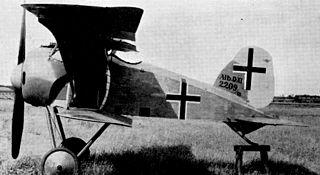
The Idflieg designation system was used to classify German heavier-than-air military aircraft from the early days of the Fliegertruppe/Luftstreitkräfte to the end of World War I. The system evolved during this period as new classes of aircraft came into use.
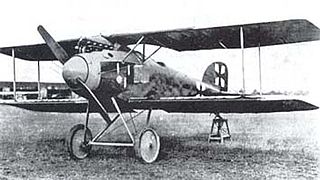
The Albatros D.II was a German fighter aircraft used during World War I. After a successful combat career in the early Jagdstaffeln, it was gradually superseded by the Albatros D.III.

The Zeppelin-Staaken R.VI was a four-engined German biplane strategic bomber of World War I, and the only Riesenflugzeug design built in any quantity.
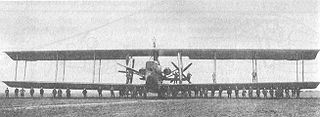
A Riesenflugzeug, sometimes colloquially referred to in English as an R-plane, was any member of a class of large World War I German bombers, possessing at least three aircraft engines, although usually four or more engines. These were large multi-engine aircraft capable of flying several hours with larger bomb loads than the smaller Grossflugzeug bombers such as the Gotha G.V.
The DFW R.I,, was a prototype German bomber aircraft of World War I.
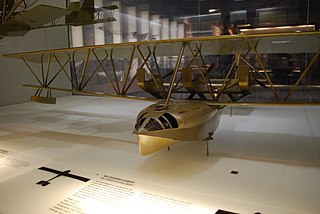
The Zeppelin-Lindau Rs.I was a large three-engined biplane flying boat designed by Claudius Dornier and built during 1914–15 on the German side of Lake Constance. It never progressed beyond taxiing trials as it was destroyed in a storm.
The Siemens-Schuckert R.I was a bomber aircraft built in Germany during World War I. It was originally ordered as the Siemens-Schuckert G.I prior to the German Inspectorate of Flying Troops adopting the "R" classification for multi-engine aircraft in late 1915. Some sources refer to the aircraft as the Siemens-Schuckert Steffen R.I, including the name of the brothers that designed it.

The Siemens-Schuckert Forssman was a prototype bomber aircraft designed and built in Germany in 1914 and 1915. When its performance proved inadequate for its intended role, even after numerous modifications, the German Inspectorate of Flying Troops eventually accepted it into service as a trainer. Shortly after its acceptance into military service, the aircraft's fuselage fractured while on the ground, ending its career.

The Siemens-Schuckert R.VIII was a bomber aircraft designed and built in Germany from 1916.

The Siemens-Schuckert R.II was a prototype bomber aircraft built in Germany during World War I. It was one of six aircraft based on the Siemens-Schuckert R.I that were originally intended to be identical, but which each developed in a different direction and were designated as different aircraft types by the German Inspectorate of Flying Troops. Although the R.II was the first of the batch to be completed, it was the last accepted into military service, and then only as a trainer.
The Siemens-Schuckert R.III was a prototype bomber aircraft built in Germany during World War I. It was one of six aircraft based on the Siemens-Schuckert R.I that were originally intended to be identical, but which each developed in a different direction and were designated as different aircraft types by the German Inspectorate of Flying Troops. The aircraft's development was impeded by the unreliability of its Maybach HS engines, and when it was eventually accepted for military service, it was only in a training role.
The Siemens-Schuckert R.V was a bomber aircraft built in Germany during World War I. It was one of six aircraft based on the Siemens-Schuckert R.I that were originally intended to be identical, but which each developed in a different direction and were designated as different aircraft types by the German Inspectorate of Flying Troops. Development of the R.V benefited from the experience that Siemens-Schuckert and the Idflieg had gained with the R.II, R.III, and R.IV, particularly in its choice of powerplants, where the R.V was spared from the troublesome Maybach HS engine. Between September 1916 and February 1917, the aircraft saw service on the Eastern Front before it was damaged in an accident and dismantled for spare parts.
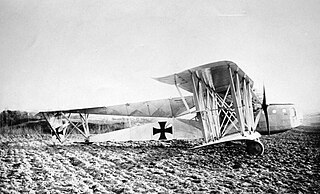
The Siemens-Schuckert R.VI was a bomber aircraft built in Germany during World War I. It was one of six aircraft based on the Siemens-Schuckert R.I, which were originally intended to be identical. Each developed in a different direction and were designated as different aircraft types by the German Inspectorate of Flying Troops.

The Siemens-Schuckert R.VII was a bomber aircraft built in Germany during World War I. It was one of six aircraft based on the Siemens-Schuckert R.I that were originally intended to be identical, but which each developed in a different direction and were designated as different aircraft types by the German Inspectorate of Flying Troops.
The Zeppelin-Staaken R.VII was six-engined large bomber - a Riesenflugzeug - of Imperial Germany, intended to be less vulnerable than the airships in use at the time.

The Zeppelin-Staaken R.V was one of a series of large bombers called Riesenflugzeugen, intended to be less vulnerable than the rigid airships in use at the time.

The Zeppelin-Staaken Riesenflugzeuge were a series of very large bomber aircraft - Riesenflugzeuge, usually powered by four or more engines, designed and built in Germany from 1915 to 1919.
The Maybach Mb.IV, originally designated Maybach HS,, was a six cylinder in-line piston engine of 250 hp (190 kW) output, originally developed for use in airships. It was also used for large aircraft such as the Zeppelin-Lindau Rs.I giant seaplane.

The Siemens-Schuckert L.I was a large, three-engined biplane bomber aircraft, built in Germany towards the end of World War I. It was a twin boom design, strongly influenced by the successful Caproni Ca.3. Three were built but not used operationally.

The Zeppelin-Lindau Rs.IV was a Riesenflugzeug monoplane all metal flying boat with a stressed skin hull an fuselage developed for the Imperial German Navy to perform long range patrols over the North Sea. It had been developed by Claudius Dornier while working for Zeppelin in the town of Lindau.
References
- Gray, Peter; Owen Thetford (1962). German Aircraft of the First World War. London: Putnam.
- Haddow, G.W.; Peter M. Grosz (1962). The German Giants: The Story of the R-planes 1914–1919. London: Putnam.
- The Illustrated Encyclopedia of Aircraft. London: Aerospace Publishing.
- Taylor, Michael J.H. (1989). Jane's Encyclopedia of Aviation. London: Studio Editions.